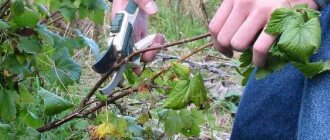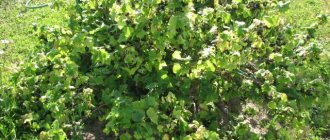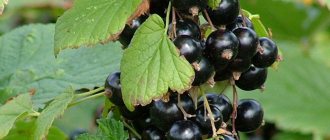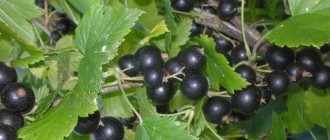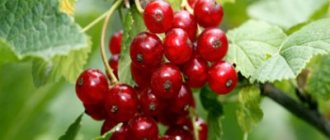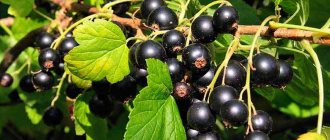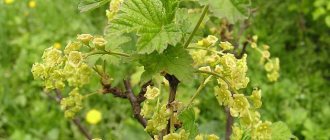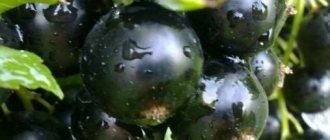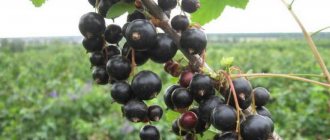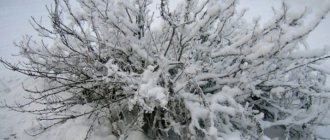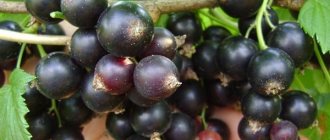Description of the blackcurrant variety Treasure
Treasure is a blackcurrant variety bred at the Federal Altai Scientific Center for Agrobiotechnology. Received in the early 90s of the XX century. L.N. Zabelina. In 1997 it was included in the register of selection achievements. Approved for cultivation in Western and Eastern Siberia.
The black currant bush of the Treasure variety is medium tall (130–150 cm), moderately spreading, the crown is not too thick. The shoots are straight, of medium diameter. Young branches are light green, have slight pubescence along the entire length, the top is reddish-purple. Adult shoots become woody, light brown, and also pubescent.
The buds are small, solitary, deviating from the shoot. The shape is ovoid, pointed, light green in color, scales are noticeable. The apical bud is grouped with others. The leaves of the black currant variety Treasure are three-lobed, small, light green in color, and have no pubescence. The surface is leathery, wrinkled, slightly shiny, and bends into veins.
The middle lobes are small, elongated, folded along the veins. The basal ones are well developed, less often only one lobe is expressed. An open, shallow notch is visible at the base of the leaf. The main veins are light green in color. The teeth on the edges are small and pointed. The petioles are thick, but short, green in color, and have slight pubescence. In relation to the shoot, they are located at an angle of 45 degrees.
The flowers of the black currant variety Treasure are medium in size. The petals are cream-colored, the sepals are pink. The clusters come in triple and single clusters, each producing 5–10 berries. The stalks are small and thick, strong, bright green in color, and have slight pubescence.
According to the description of the black currant variety Sokrovische, as well as photos and reviews from summer residents, the berries are distinguished by the following features:
- large sizes - weight from 1.6 to 2.1 g;
- oval shape;
- dark color;
- the surface gloss is low;
- many seeds, small;
- thin skin;
- dry separation;
- The taste is balanced, sweet and sour.
Treasure blackcurrant berries have a pleasant taste
Chemical composition of the pulp (in proportions of the total mass):
- dry matter – up to 14.5%;
- sugar – up to 8.1%;
- acids in total – up to 3.8%;
- Vitamin C content is about 75–100 mg per 100 g.
Attention! The black currant variety Treasure is self-fertile and early-fruiting.
The ovaries are formed without the participation of pollinators, the berries ripen early.
Characteristics
The black currant variety Sokrovische is intended for cultivation in the climatic conditions of Western and Eastern Siberia. The culture tolerates unfavorable weather well and is not afraid of winter frosts.
Drought resistance, frost resistance
The variety is winter-hardy, can withstand up to -34 °C without shelter. Does not tolerate drought very well. If the weather is hot, it is necessary to ensure regular watering at least once a week.
Productivity
Black currant Sokrovische is an early ripening variety. Flowering begins in mid-May, ripening in mid-July. The yield is good - from an adult bush you can collect 4-5 kg of tasty berries. If grown on an industrial scale, the figure is 6.3 tons per hectare.
The berries do not fall off even after ripening. If the moisture is normal, the fruits do not become smaller and do not bake in the sun. The skin of the fruit is durable, so they can be stored in the refrigerator for up to 2 weeks (at temperatures up to 10 degrees). The fruits are transportable.
Application area
Black currant berries of the Sokrovische variety are delicious and can be eaten fresh or with sugar. They are also suitable for preservation in the form of:
- jam;
- jams;
- fruit drink;
- compotes and other dishes.
Thanks to the strong skin, the berries can be transported even over long distances.
Advantages and disadvantages
The black currant variety Sokrovische is valued by summer residents for its good yield, resistance to frost and other qualities.
Black currant berries of the Sokrovische variety are large, do not burst or fall off
pros
- sufficient yield;
- pleasant taste;
- good keeping quality and transportability;
- amicable maturation;
- fruits with dry detachment;
- self-fertility and early pregnancy;
- resistance to bud mite and hazel grouse.
Minuses
- bushes age quickly;
- demanding care;
- the crop does not tolerate drought and drafts.
Reproduction methods
You can propagate black currant variety Treasure by any means:
- cuttings;
- layering;
- dividing the bush.
Green cuttings are cut at the end of spring, soaked in a growth stimulant (Epin, Kornevin, Zircon), grown under a film in moist, fertile soil, mulched for the winter, and transplanted to a permanent place in April.
Reproduction by layering is also carried out at the beginning of the season. The lower branches are immersed in ditches and sprinkled with fertile soil, leaving only the tops. In the fall, they are cut off from the mother bush and transferred to a permanent place. In winter, water and mulch abundantly.
Mature currant bushes Treasure can be divided in early April. They are dug up and cut into several parts, and the cut points are sprinkled with coal. Planted in fertile soil, deepening the root collar by 5–7 cm, then watered abundantly and urea was added.
Attention! The greatest fruiting is observed in the period from the fifth to the seventh year of growth. Then the bushes begin to age.
It is recommended to separate seedlings in the eighth year of life.
Landing
To plant black currants of the Sokrovische variety, choose an open area on a hill, well protected from the wind. Seedlings can be purchased in the fall to be planted at the end of September, but spring planting in April is also allowed. Preparation begins in advance - the soil is dug up and 3-5 kg of compost or humus is added per square meter. If the soil is too heavy or dense, you need to add 500–700 g of sawdust or sand to the same area.
Treasure blackcurrant bushes are planted at a distance of 1.5 m from each other
The landing algorithm is standard:
- Over a month, several holes with a depth of 50–60 cm are prepared at a distance of 150 cm.
- Fill up fertile soil.
- After a month, they begin planting: the seedlings are soaked in a growth stimulator (several hours).
- Root at an angle of 45 degrees, sprinkle a layer of soil on top so that the root collar goes 5–7 cm from the surface.
- Water abundantly and mulch for the winter with peat, sawdust, leaves, pine needles or other material.
Specifics of planting work
To obtain a high-quality harvest and maintain the productivity of the bush, you need to choose the right place and follow the planting technique.
See also
Why currant leaves curl, how to deal with it and how to treat it
Read
Site selection and site preparation
Currants prefer places with good sunlight. It should last at least 12 hours a day in the summer. The culture loves well-ventilated areas, but without north winds.
Important!
Cold gusty wind will lead to the death of the bush. It is preferable to use soil with a slightly acidic environment. If the acidity is higher, then the soil is limed. The site is prepared in advance, no later than 2 weeks before planting. To do this, certain actions are carried out:
- All large stones and weeds are removed from the garden bed.
- Dig a hole 50 cm deep and 30 cm in diameter.
- The excavated soil is mixed with humus and a mineral complex containing nitrogen, phosphorus, and potassium.
- Half of the mixture is placed back into the pit.
- Leave for 2 weeks or until spring.
Planting dates and technology
For temperate and northern climates, planting is recommended in early spring. At a time when the snow has completely melted and the top layer of soil has thawed. Autumn planting is also possible, but the survival rate of the seedling is reduced.
Important! If the seedling was purchased in the fall, then it is stored in a greenhouse with the roots lightly buried until spring in a horizontal position.
The procedure for planting shrubs is the same as for other crops. Follow the following algorithm:
- The young plant is soaked in a solution of potassium permanganate for a day.
- The plant is placed in a hole.
- Straighten all the roots with your hands.
- Seal the hole layer by layer.
- Each layer is compacted tightly.
- The penultimate layer is peat.
- Water the currants with 10 liters of water.
Aftercare
Further care for black currant variety Sokrovische includes the following actions:
- Watering in the first months after planting and in hot weather - weekly, then - 2 times a month: 1.5–2 buckets per bush.
- Feeding: in the spring with urea 15–20 g per 10 l, at the end of August - with potassium salt (20 g) and superphosphate (20 g per 10 l). Every 4–5 years it is recommended to add slaked lime (200 g per 1 m2) to the soil.
- For the winter, the soil must be mulched.
- Weed regularly.
- The soil is loosened 2-3 times per season.
- When planting and the following year, black currant seedlings of the Sokrovische variety are pruned, leaving 5–6 buds. Then pruning is carried out every spring, removing dead branches.
- It is not necessary to cover for the winter, since the black currant variety Sokrovische is winter-hardy. Young seedlings can be mulched and covered with leaves, spruce branches or sawdust.
- To protect bushes from rodents, you can stretch a net around the trunks.
Varieties
The green color of the berries is inherited from Siberian and Scandinavian blackcurrant varieties. At the All-Russian Research Institute of Genetics and Selection of Fruit Plants named after I.V. Michurin, 77 green-fruited currant seedlings were produced through hybridization, free and forced pollination.
Vertti
This is a variety of Finnish selection. The berries have a light green color, thin skin, excellent taste and aroma. The shrub is able to bear fruit after the first year of life. The berries ripen in late June - July. Productivity is above average. The variety is cold-resistant, but in prolonged frosts of -30°C, flower buds may be damaged.
The positive qualities of the Vertti variety include resistance to fungal diseases. Spider mite damage is rarely observed, which causes considerable harm to black currants.
Pests and diseases
Black currant variety Treasure is resistant only to certain diseases. Therefore, preventive treatment with fungicides is mandatory. It is carried out in early spring, before the buds awaken. Effective fungicides are used for spraying: Bordeaux mixture, Fitosporin, Hom, Maxim, Fundazol.
You can get rid of insects using folk remedies:
- a solution of wood ash with laundry soap;
- infusion of onion peel;
- decoction of marigold flowers or potato tops;
- infusion of garlic cloves;
- infusion of tobacco dust.
If there are a lot of pests, insecticides are used: “Decis”, “Aktara”, “Inta-Vir”, “Green Soap”, “Confidor”.
If spots appear, currant leaves must be removed and then immediately treated with a fungicide.
Important! Spraying of black currant bushes of the Sokrovische variety is carried out in the evening, in dry and little windy weather. You can harvest the crop 3–5 days after the procedure.
Advantages and disadvantages
There are more advantages about the Treasure variety than disadvantages. Basic:
- Large berries, good taste.
- Very high yields.
- Uniform color of each berry in the currant cluster.
- Precociousness.
- Winter hardiness.
- Good resistance to most currant diseases and pests. Rust and powdery mildew do not affect the bushes at all, anthracnose, septoria, and bud mites occur, but the problem can be 90% solved with preventive treatments.
The main disadvantage of the plant is that it does not tolerate drought well. In order not to lose crops, do not forget about high-quality, timely watering.
It is not necessary to cover the variety for the winter, but it is advisable. The same can be said about the presence of cross pollinators on the site - with them the yield will be higher, but without them it is also possible.
